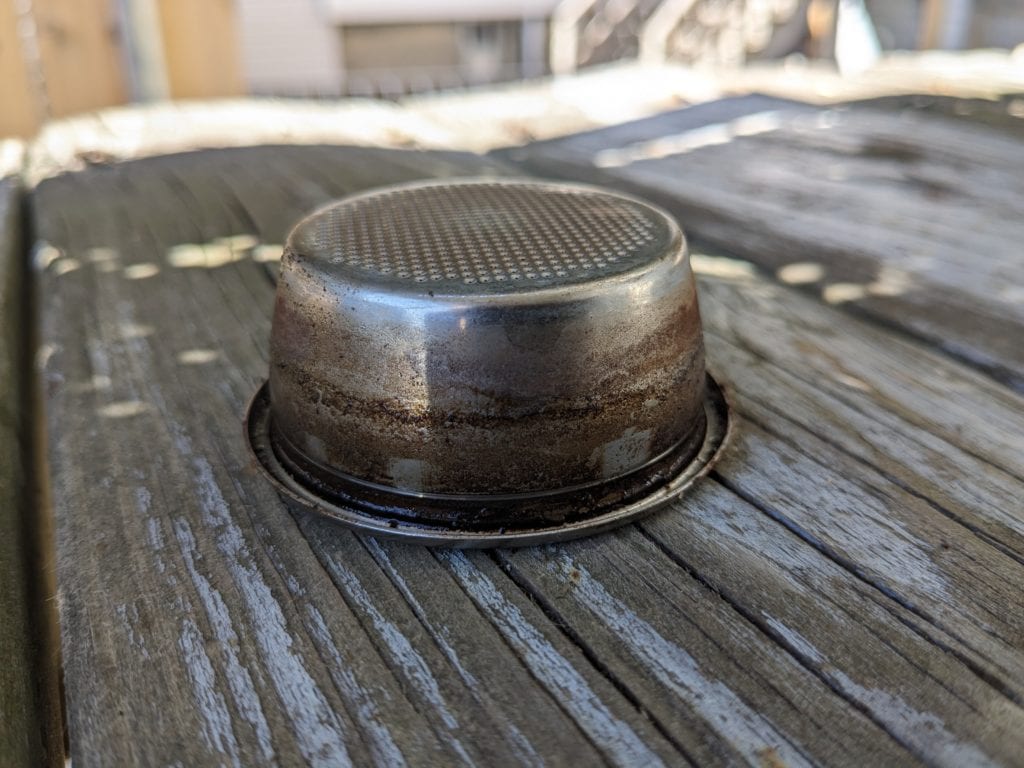TL:DR: Use magic erasers to scour buildup off stainless steel walls. Leave plastic lids outside for weeks/months until the detergent scent completely dissipates.
I recently took a vacation to Fort Meyers, Florida. Washing dishes in my hotel suite, I noticed the Fort Meyers water had a distinct fishy odor, the odor of the Floridan Aquifer from which it is drawn, I supposed. Then, at a secondhand store, I snagged a pair of completely filthy Yeti tumblers. The tumblers reeked of the Floridan Aquifer. The fishy smell was so strong you could smell it four inches away from the cup.
I buy a lot of secondhand Yetis. They always have the same problems: horrible stinking buildup inside the cups, and plastic lids that smell and taste of the vile fragrances of dish soap or dishwashing detergent. Reusable stainless steel drinkware requires an incredible amount of maintenance if it is to remain clean and odor-free. Before I arrived at my current drinkware-cleaning approach, I tried many things, all of which failed completely. Some of those things are mentioned in this Reddit post.
- Descaling products/acids (citric acid, vinegar, lemon juice, etc.) never worked for me, either to clean the insides of Yeti tumblers or to get detergent stench off plastic lids. There’s something strange about the fact that these products don’t work at all on Yeti stainless steel, yet are so effective on other stainless steel. For example, when I clean my water-boiling kettle, I dump in some citric acid, fill it with water, and allow it to soak overnight. The next day, the hard-water buildup on the bottom of the kettle flakes off with the gentle touch of a bottle brush. Unlike the shiny stainless steel in my kettle, the walls of a Yeti tumbler definitely have a matte look. Perhaps the manufacturing process of these cups gives their stainless steel walls a grainy texture.
- Strong Bases (baking soda, bleach, OxyClean Free, washing soda): Baking soda and/or bleach did not diminish soap fragrances that were attached to plastic, even when I let things soak for eternity or boiled the plastic in baking-soda water. I haven’t tried OxyClean Free, which was mentioned in the Reddit post. Nor would I bother. I know the main ingredients of OxyClean are sodium percarbonate, aka washing soda, and sodium percarbonate peroxide, which I think is washing soda with a peroxide ion to make it more reactive. I use washing soda to do my laundry. In my experience, it is fairly effective against biological odors (such as those mentioned by the Redditors that come about in the process of home-brewing.) Its power wanes against the vile, super-sticky, man-made “forever” fragrances of soaps and detergents such as those on the secondhand clothes I buy. Like the Cascade dishwashing detergent or Dawn dish soap on a Yeti lid, these fragrances are Proctor and Gamble specialties: Bounce dryer sheets. Downy. Gain. Tide. These stenches are built tough and made to last.
- Denture tablets: Denture tablets are mentioned a few times in the Reddit post. Looking at their ingredients, I’d say they’re part descaling and part strong bases. I wouldn’t bother.
- The dishwasher: The dishwasher will never remove the crap that accumulates inside your Yetis. It will only add to the hard-water buildup whilst imparting the fragrance and flavor of the dishwashing tablet you used. If you would like to dishwash your plastic Yeti lids, purchase fragrance-free detergent or make your own using a recipe such as this one from The Spruce. Then you can use the dishwasher for plastic (and for silicone bags, spatulas, etc. which also soak up fragrances like crazy). Plus, if you choose to make your own detergent, you won’t be relying on enzymes anymore. I read in The End of the Food Allergy that even in very low concentrations, the protein-rending enzymes used in laundry and dishwashing detergents are known to tear apart human cells.
Use Magic Eraser to Scour Delicate Stainless Steel Surfaces
Most people who cook with stainless steel pots and pans give them a good scouring every now and again. If you use steel wool to scour a pot, and then dry the pot, you may notice grey streaks on the towel. Indeed, this is stainless steel rubbed away into nothingness. Steel-wool scouring removes layers of hard-water stains, or gnarly food and oil residues, and with it takes a layer of stainless steel. That’s the nature of the beast. Those who work in the restaurant industry tell of restaurants in which pots are, over time, scoured into nothingness. (Anthony Bourdain, in Kitchen Confidential, tells of a wise restaurant manager who always purchased cookware with a lifetime warranty, and then got each piece replaced after it’d been scoured to tatters.)
If you use steel wool inside a Yeti, it leaves deep, permanent scratches.
Magic Erasers are like a soft, foamy block of micro-sandpaper. They’re perfect for removing any kind of residue from coffee/tea filters or the inside walls of a Yeti. The “sheet” versions of Magic Erasers are wide and flat, rather than brick-shaped. These can also be used almost like a dish cloth. I like to use them on pots and pans, too, because they don’t rip off any stainless steel.
- Benefits: Works quickly on all stainless steel surfaces, even perforated ones such as tea filters. No steel-wool mess or chemicals to mix.
- Drawbacks: Stainless steel drinkware and gear needs frequent cleaning. Magic Erasers and their competitors are expensive and short-lasting, though you can cut a single eraser into hunks to make it last longer. Multiple people have told me that Magic Erasers are irritating to their skin—consider wearing gloves while using them.


Leave Plastic Lids Outside Until Nature Overtakes Proctor and Gamble
Leaving Yeti lids outside is the only way I’ve ever removed soap fragrances. Nothing else has ever worked for me. I try to leave them in a location that is not completely exposed 24-7, but receives some sunlight and some rain or snow for a good portion of the day. I’ve left some lids outside for several weeks. Some were outside for a month or more. None were ever ruined by this experiment, although a few had the fragrance re-emerge several months later and had to take another trip outside.
- Benefits: You don’t have to buy anything. You don’t have to do anything, except be patient.
- Drawbacks: You won’t be using your Yeti any time soon.
Note: I’ve left silicone spatulas and other silicone utensils outside to remove soap fragrances. Unfortunately, Mother Nature didn’t seem to work her magic. I suspect silicone gear is too porous, and sunlight can’t reach all deeply embedded fragrance molecules.
A Dirty Cup (or Dirty Equipment) Makes a Drink Taste Dirty
When a Yeti tastes like dish soap, it’s insufferable. But you might think coffee and tea buildup are par for the course. I had a coworker who for years drank coffee from the same unwashed cup. For a couple years I too used the same tea strainer. Eventually it looked dull, with a thick powdery coating. I thought this was okay—it was just tea, after all. Finally I scoured it, returning it to a new, shiny condition. The next day, my tea tasted fresh, clean, and amazing. I shouldn’t have been so surprised that a dirty cup makes a drink taste dirty!








